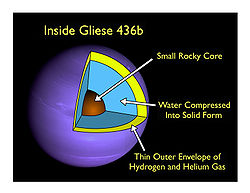格利泽436b
| 太阳系外行星 | 太阳系外行星列表 | |
|---|---|---|
 | ||
| 母恒星 | ||
| 母恒星 | Gliese 436 | |
| 星座 | 狮子座 | |
| 赤经 | (α) | 11h 42m 11.0941s[1] |
| 赤纬 | (δ) | +26° 42′ 23.652″[1] |
| 距离 | 33.4 ly (10.2 pc) | |
| 光谱类型 | M2.5 V[1] | |
| 轨道参数 | ||
| 半长轴 | (a) | 0.0291±0.0004[2] AU |
| 轨道离心率 | (e) | 0.150±0.012[2] |
| 公转周期 | (P) | 2.643904±0.000005[3] d (0.00723849 y) |
| 轨道倾角 | (i) | 85.8+0.21 −0.25[3]° |
| 角距 | (θ) | 2.794 mas |
| 近星点时间 | (T0) | 2,451,551.716 ±0.01 JD |
| 半振幅 | (K) | 18.68±0.8 m/s |
| 物理性质 | ||
| 质量 | (m) | 22.2±1.0[2] M🜨 |
| 半径 | (r) | 4.327±0.183[2][4] R🜨 |
| 密度 | (ρ) | 1.51 g cm-3 |
| 表面重力 | (g) | 1.18 g |
| 温度 | (T) | 712±36[2] K |
| 发现 | ||
| 发现时间 | 2004 | |
| 发现者 | 巴特勒、沃格特、 马西 et al. | |
| 发现方法 | 径向速度、凌日法 | |
| 发现地点 | 美国加利福尼亚州 | |
| 发表论文 | 出版 | |
| 其他名称 | ||
Ross 905 b, GJ 436 b,[5] LTT 13213 b, GCTP 2704.10 b, LHS 310, AC+27:28217 b, Vyssotsky 616 b, HIP 57087 b, GEN# +9.80120068 b, LP 319-75 b, G 121-7 b, LSPM J1142+2642 b, 1RXS J114211.9+264328 b, ASCC 683818 b, G 147-68 b, UCAC2 41198281 b, BPS BS 15625-0002 b, G 120-68 b, 2MASS J11421096+2642251 b, USNO-B1.0 1167-00204205 b, CSI+27-11394 b, MCC 616 b, VVO 171 b, CSI+27-11395 b, HIC 57087 b, NLTT 28288 b, Zkh 164 b, CSI+26-11395 b, [RHG95] 1830 b, GCRV 7104 b, LFT 838 b, PM 11395+2700 b
| ||
| 数据库参考 | ||
| 太阳系外行星 百科全书 | data | |
| SIMBAD | data | |
格利泽436b(英语:Gliese 436 b,/ˈɡliːzə/)是一个环绕格利泽436的系外气态巨行星,其大小与海王星差不多。由于离母恒星非常的近,故其表面温度很高,达712 K(439 °C)。有趣的是,虽然格利泽436b的表面温度极高,但是其内部气压非常大,因此其表面上的水蒸气会凝结成冰或水。[6]
发现
[编辑]格利泽436b是于2004年8月被华盛顿卡内基研究所的R·保罗·巴特勒和加州大学的史蒂文·沃格特发现,他们是使用径向速度测量法发现这颗行星的。同时,他们亦发现了巨蟹座55e。这两颗行星是首批被发现的系外类海王星行星,即冰巨星。
于2005年1月11日,新墨西哥州立大学的自动巡天系统透过凌日法发现了这颗行星,但这个发现没有受到重视。[7]于2007年,吉隆带领着一个观察了行星凌日的团队,并透过再次测量凌日,计算出其精确的质量和半径数据,并发现这颗行星与海王星非常相似。在当时,格利泽436b成为了透过凌日法发现的体积最小的行星。这颗行星的直径比天王星长约4000公里,比海王星长约5000公里,且质量稍比海王星高。其半长轴长4,000,000公里,比水星的半长轴短15倍。
物理特性
[编辑]

因为与母星的距离过于接近,格利泽436b的表面温度被母星加热至712 K(439 °C),因此是一个热海王星。[2]天文学家相信如此高温并不可能仅仅被恒星辐射加热就可达到,而是加上潮汐效应才达到的。[8]而且,温室效应亦会导致温度升高,如金星。[9]
尽管其表面温度极高,但冰仍能存在于这颗行星上。这些“冰”是因为高压压缩而成[9][6],而这是因行星本身的强引力所致。[10]这颗行星很可能在距离母星更远的地方形成,并且原本是一个类木行星,但后来逐渐接近母星后,其表面厚厚的氢气大气被日冕物质抛射吹走,才变成现今的模样。[11]
然而,随着其半径逐渐为人所理解,冰便不足以构成整颗行星。在冰上,浮着占总质量10%的氢气和氦气。[2][3]这颗行星也可能是一个超级地球。[12]
天文学家使用斯皮策空间望远镜测量格利泽436b的亮度温度,并发现这颗行星的大气可能存在热化学不平衡。他们得出这颗行星的大气含有丰富的一氧化碳,并缺乏甲烷。这个结果是出乎意料的,因为天文学家们认为其甲烷浓度应比一氧化碳高。[13][14][15][16]
轨道特征
[编辑]格利泽436b的轨道半长轴为0.0291±0.0004 AU,轨道周期为2天15.5小时。[2]其轨道与母星的自转亦呈错位状态。[15]这颗行星的轨道离心率亦可能被高估,但要准确测量一个行星的轨道离心率,就必须有另一个行星的存在。[2][17]于2012年,天文学家们在同一个行星系中又发现了两个未被证实的行星。[18]
参见
[编辑]参考文献
[编辑]- ^ 1.0 1.1 1.2 LHS 310. Simbad. Centre de Données astronomiques de Strasbourg. [2007-11-28]. (原始内容存档于2012-02-24).
- ^ 2.0 2.1 2.2 2.3 2.4 2.5 2.6 2.7 2.8 Drake Deming; Joseph Harrington; Gregory Laughlin; Sara Seager; Navarro, Sarah B.; Bowman, William C.; Karen Horning. Spitzer Transit and Secondary Eclipse Photometry of GJ 436b. The Astrophysical Journal. 2007, 667 (2): L199–L202. Bibcode:2007ApJ...667L.199D. arXiv:0707.2778
 . doi:10.1086/522496.
. doi:10.1086/522496.
- ^ 3.0 3.1 3.2 Bean, J.L.; et al. A Hubble Space Telescope transit light curve for GJ 436b. Astronomy & Astrophysics. 2008 [2021-12-31]. (原始内容存档于2010-04-08).
- ^ Confirmed, Pont, F.; Gilliland, R. L.; Knutson, H.; Holman, M.; Charbonneau, D. Transit infrared spectroscopy of the hot neptune around GJ 436 with the Hubble Space Telescope. Monthly Notices of the Royal Astronomical Society: Letters. 2008, 393: L6–L10. Bibcode:2009MNRAS.393L...6P. arXiv:0810.5731
 . doi:10.1111/j.1745-3933.2008.00582.x.
. doi:10.1111/j.1745-3933.2008.00582.x.
- ^ Maness; Marcy, G. W.; Ford, E. B.; Hauschildt, P. H.; Shreve, A. T.; Basri, G. B.; Butler, R. P.; Vogt, S. S.; et al. The M Dwarf GJ 436 and its Neptune-Mass Planet. Submitted to Publications of the Astronomical Society of the Pacific. 2006, 119 (851): 90–101. Bibcode:2007PASP..119...90M. arXiv:astro-ph/0608260
 . doi:10.1086/510689.
. doi:10.1086/510689.
- ^ 6.0 6.1 Shiga, David. Strange alien world made of "hot ice". New Scientist. 6 May 2007 [2007-05-16]. (原始内容存档于2008-07-06).
- ^ Coughlin, Jeffrey L.; Stringfellow, Guy S.; Becker, Andrew C.; Mercedes Lopez-Morales; Fabio Mezzalira; Tom Krajci. New observations and a possible detection of parameter variations in the transits of Gliese 436b. The Astrophysical Journal. 2008, 689 (2): L149–L152. Bibcode:2008ApJ...689L.149C. arXiv:0809.1664
 . doi:10.1086/595822.
. doi:10.1086/595822.
- ^ Brian Jackson; Richard Greenberg; Rory Barnes. Tidal Heating of Extra-Solar Planets. The Astrophysical Journal. 2008, 681 (2): 1631–1638. Bibcode:2008ApJ...681.1631J. arXiv:0803.0026
 . doi:10.1086/587641.
. doi:10.1086/587641.
- ^ 9.0 9.1 M. Gillon; et al. Detection of transits of the nearby hot Neptune GJ 436 b (PDF). Astronomy and Astrophysics. 2007, 472 (2): L13–L16 [2013-12-15]. Bibcode:2007A&A...472L..13G. arXiv:0705.2219
 . doi:10.1051/0004-6361:20077799. (原始内容存档 (PDF)于2020-10-21).
. doi:10.1051/0004-6361:20077799. (原始内容存档 (PDF)于2020-10-21).
- ^ Fox, Maggie. Hot "ice" may cover recently discovered planet. Science News (Scientific American.com). May 16, 2007 [2008-08-06]. (原始内容存档于2020-10-11).
- ^ H. Lammer; et al. The impact of nonthermal loss processes on planet masses from Neptunes to Jupiters (PDF). Geophysical Research Abstracts. 2007, 9 (07850) [2013-12-15]. (原始内容存档 (PDF)于2019-12-15). By analogy with Gliese 876 d.
- ^ E. R. Adams, S. Seager, and L. Elkins-Tanton. Ocean Planet or Thick Atmosphere: On the Mass-Radius Relationship for Solid Exoplanets with Massive Atmospheres. The Astrophysical Journal. February 2008, 673 (2): 1160–1164. Bibcode:2008ApJ...673.1160A. arXiv:0710.4941
 . doi:10.1086/524925.
. doi:10.1086/524925.
- ^ Possible thermochemical disequilibrium in the atmosphere of the exoplanet GJ 436b. Nature. 22 April 2010, 464: 1161–1164 [2013-12-15]. Bibcode:2010Natur.464.1161S. arXiv:1010.4591
 . doi:10.1038/nature09013. (原始内容存档于2011-09-27).
. doi:10.1038/nature09013. (原始内容存档于2011-09-27).
- ^ GJ436b - Where's the methane? 互联网档案馆的存档,存档日期2010-05-14. Planetary Sciences Group at the University of Central Florida, Orlando
- ^ 15.0 15.1 Knutson, Heather A. A Spitzer Transmission Spectrum for the Exoplanet GJ 436b. Astrophysical Journal. 2011,. 735, 27. Bibcode:2011ApJ...735...27K. arXiv:1104.2901
 . doi:10.1088/0004-637X/735/1/27.
. doi:10.1088/0004-637X/735/1/27.
- ^ LINE, Michael R.; VASISHT, Gautam; CHEN, Pin; ANGERHAUSEN, D.; YANG, Yuk L. Thermochemical and Photochemical Kinetics in Cooler Hydrogen Dominated Extrasolar Planets. Astrophysical Journal. 2011,. 738, 32. Bibcode:2011ApJ...738...32L. arXiv:1104.3183
 . doi:10.1088/0004-637X/738/1/32., abstract in the arXiv titled "Thermochemistry and Photochemistry in Cooler Hydrogen Dominated Extrasolar Planets: The Case of GJ436b"
. doi:10.1088/0004-637X/738/1/32., abstract in the arXiv titled "Thermochemistry and Photochemistry in Cooler Hydrogen Dominated Extrasolar Planets: The Case of GJ436b"
- ^ Bean, Jacob L.; Andreas Seifahrt. Observational Consequences of the Recently Proposed Super-Earth Orbiting GJ436. 2008. arXiv:0806.3270
 [astro-ph].
[astro-ph].
- ^ Reuters. Alien exoplanet smaller than Earth discovered. Sydney Morning Herald. July 2012 [2012-07-19]. (原始内容存档于2014-04-11).
